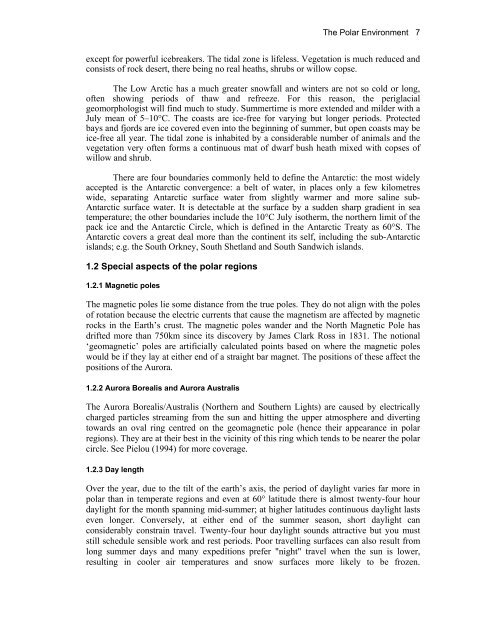Edited by Rachel Duncan 4th Edition ISBN 0-907649-91-2 London ...
Edited by Rachel Duncan 4th Edition ISBN 0-907649-91-2 London ...
Edited by Rachel Duncan 4th Edition ISBN 0-907649-91-2 London ...
You also want an ePaper? Increase the reach of your titles
YUMPU automatically turns print PDFs into web optimized ePapers that Google loves.
The Polar Environment 7<br />
except for powerful icebreakers. The tidal zone is lifeless. Vegetation is much reduced and<br />
consists of rock desert, there being no real heaths, shrubs or willow copse.<br />
The Low Arctic has a much greater snowfall and winters are not so cold or long,<br />
often showing periods of thaw and refreeze. For this reason, the periglacial<br />
geomorphologist will find much to study. Summertime is more extended and milder with a<br />
July mean of 5–10°C. The coasts are ice-free for varying but longer periods. Protected<br />
bays and fjords are ice covered even into the beginning of summer, but open coasts may be<br />
ice-free all year. The tidal zone is inhabited <strong>by</strong> a considerable number of animals and the<br />
vegetation very often forms a continuous mat of dwarf bush heath mixed with copses of<br />
willow and shrub.<br />
There are four boundaries commonly held to define the Antarctic: the most widely<br />
accepted is the Antarctic convergence: a belt of water, in places only a few kilometres<br />
wide, separating Antarctic surface water from slightly warmer and more saline sub-<br />
Antarctic surface water. It is detectable at the surface <strong>by</strong> a sudden sharp gradient in sea<br />
temperature; the other boundaries include the 10°C July isotherm, the northern limit of the<br />
pack ice and the Antarctic Circle, which is defined in the Antarctic Treaty as 60°S. The<br />
Antarctic covers a great deal more than the continent its self, including the sub-Antarctic<br />
islands; e.g. the South Orkney, South Shetland and South Sandwich islands.<br />
1.2 Special aspects of the polar regions<br />
1.2.1 Magnetic poles<br />
The magnetic poles lie some distance from the true poles. They do not align with the poles<br />
of rotation because the electric currents that cause the magnetism are affected <strong>by</strong> magnetic<br />
rocks in the Earth’s crust. The magnetic poles wander and the North Magnetic Pole has<br />
drifted more than 750km since its discovery <strong>by</strong> James Clark Ross in 1831. The notional<br />
‘geomagnetic’ poles are artificially calculated points based on where the magnetic poles<br />
would be if they lay at either end of a straight bar magnet. The positions of these affect the<br />
positions of the Aurora.<br />
1.2.2 Aurora Borealis and Aurora Australis<br />
The Aurora Borealis/Australis (Northern and Southern Lights) are caused <strong>by</strong> electrically<br />
charged particles streaming from the sun and hitting the upper atmosphere and diverting<br />
towards an oval ring centred on the geomagnetic pole (hence their appearance in polar<br />
regions). They are at their best in the vicinity of this ring which tends to be nearer the polar<br />
circle. See Pielou (1994) for more coverage.<br />
1.2.3 Day length<br />
Over the year, due to the tilt of the earth’s axis, the period of daylight varies far more in<br />
polar than in temperate regions and even at 60° latitude there is almost twenty-four hour<br />
daylight for the month spanning mid-summer; at higher latitudes continuous daylight lasts<br />
even longer. Conversely, at either end of the summer season, short daylight can<br />
considerably constrain travel. Twenty-four hour daylight sounds attractive but you must<br />
still schedule sensible work and rest periods. Poor travelling surfaces can also result from<br />
long summer days and many expeditions prefer "night" travel when the sun is lower,<br />
resulting in cooler air temperatures and snow surfaces more likely to be frozen.

















